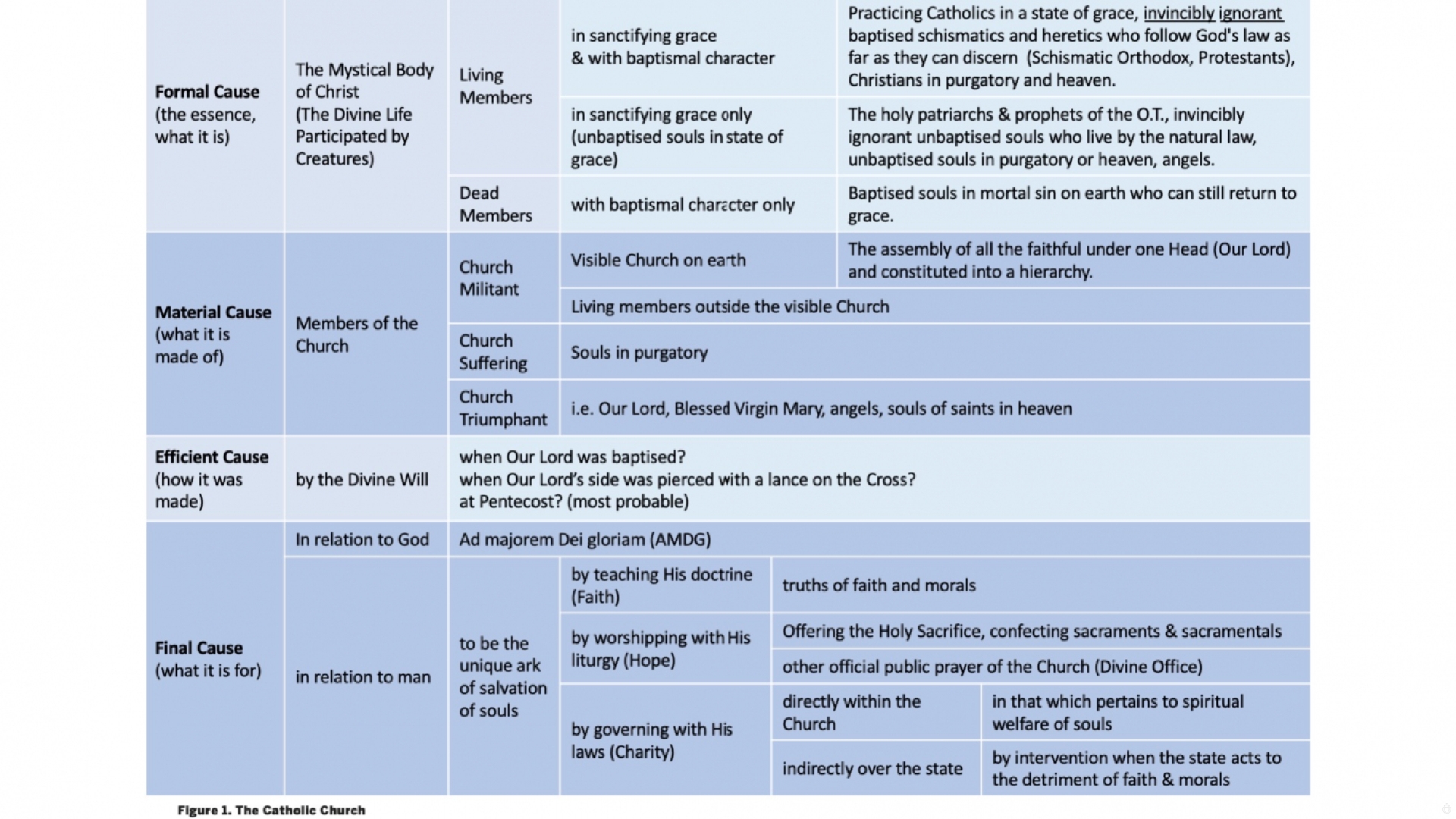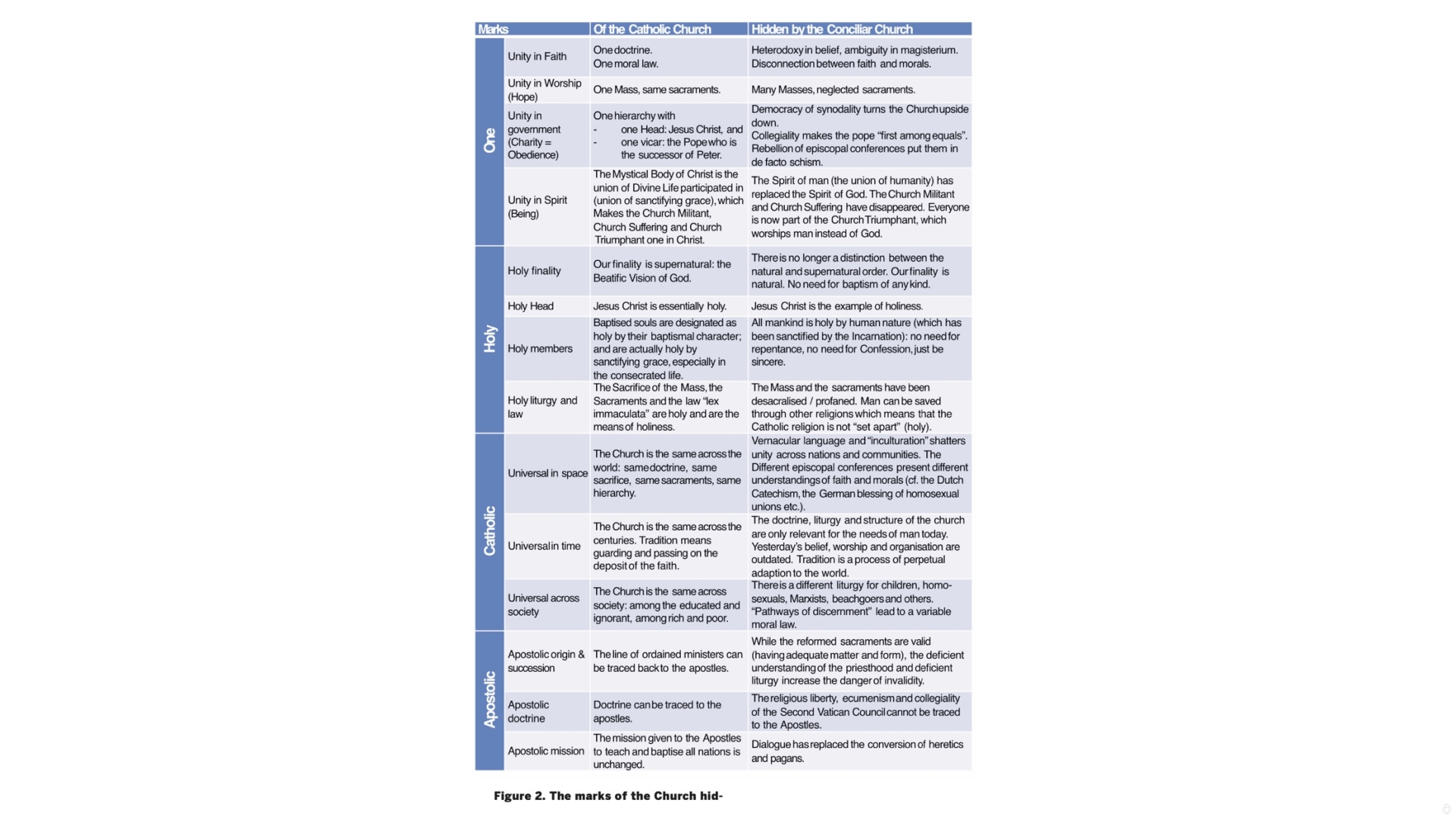The Conciliar Church and the Four Marks
Letter from the District Superior, Rev. Robert Brucciani, July 2023
My Dear Brethren,
Latest initiative of the Conciliar Church
In his recent interview with FSSPX.News, the Superior General explains the synodal process, which is the latest initiative of the Conciliar Church intended to “renew” the Catholic Church but which instead turns it upside down (see Ite Missa Est, Mar–Apr 2019) and effectively puts it at the service of a new world order which is inimical to Our Lord Jesus Christ.
It is not known whether the Pope, the cardinals or the other reformers really understand that they are leading the Lamb to the slaughter a second time, but one thing is clear: there seems to be a sense of urgency—even desperation—in their successive projects to change the Catholic Church. Perhaps there is an unseen hand forcing them. We see this in the sphere of national politics where, instead of statesmen, we see self-interested puppets dancing to another’s tune to push through evil ideological laws for which there is no real public demand. Or perhaps the reformers can see that their time is limited: the faithful have fled, structures are collapsing, the tree is without fruit and withering, and they are becoming irrelevant to the world they sacrificed everything to please.
The ruins
The afflictions of the Church readily bring to mind the Lamentations of Jeremias:
The ways of Sion mourn, because there are none that come to the solemn feast: all her gates are broken down: her priests sigh: her virgins are in affliction, and she is oppressed with bitterness. Her adversaries are become her lords, her enemies are enriched: because the Lord hath spoken against her for the multitude of her iniquities: her children are led into captivity: before the face of the oppressor. (Lam 1:4–5)
The Catholic Church, as Bride of Christ, remains beautiful and spotless, but as a visible institution, she is abandoned and tainted with scandal. As the unique means of salvation founded by Christ, she has visible marks that identify her; as the institution governed by the Conciliar Church, those marks are dimmed.
Definition of the Conciliar Church
What is this Conciliar Church that does so much harm to the Catholic Church? Is it a church within the Church? Are they two separate churches?
The Catholic Church is a visible society known by its four marks: one, holy, catholic, and apostolic. It is a supernatural society and is a perfect society because it possesses all the means to its end.

The term “Conciliar Church” was first read by Archbishop Lefebvre in a letter of 25 June 1976, received from Archbishop Benelli, the Substitute Secretary of State from 1967 to 1977. It is neither a separate church or a church within a church, but “a state of mind that prevails within the Catholic Church, even in its hierarchy, and which, wherever it prevails, prevents the full manifestation of the Church's marks and obscures its divine origin.”
(Abbé Jean-Michel Gleize, Courrier de Rome, February 2013).
Otherwise stated, the Conciliar Church is a loose society (with a small “s”) of men with modernist ideas and existing within the perfect society which is the Catholic Church. This modernist society took control of the proceedings of the Second Vatican Council, and then the levers of power within the Church—even the papacy itself. It seeks to “reform” the Church along naturalist, liberal, and sentimentalist lines—and has thereby eclipsed the marks of the Church.

Within the Church
Some might be tempted to think that members the Conciliar Church, being modernist, exclude themselves from the Catholic Church. To hold this view would be perilous for two reasons:
First, one cannot determine that a baptised soul operating within the Church excludes himself from the Church, except by a formal act of heresy, the existence of which must be declared by the authority of the Church. Souls in mortal sin remain members of the Church (albeit dead members); souls in material error (material heretics) also remain members; only souls pertinaciously holding on to heresy in the face of the Church’s formal admonition may be recognised as excluding themselves from the Church.
Second, the Church is both hierarchical (de fide) and visible (sententia certa). It must therefore have a visible head. If the Pope was no longer member of the Catholic Church because of his overt modernist tendencies then the Church would no longer be visible—and this would have been the case for the last sixty years.
It follows, therefore that the members of the Conciliar Church remain inside the Church despite the havoc they wreak. A priestly colleague suggested the analogy of the Conciliar Church being like a group of drunken officers within an army. They remain within the army, and retain the skills, rank and power to operate effectively, but their present state of inebriation brings disorder and shame upon the institution.
The future of the Conciliar Church
A house built on sand will not stand. Everything which is not of God will fail. An evil tree will bring forth evil fruit. Every lie is found out. The Conciliar Church is destined to failure by its very nature. It is a house built on religious sentiment rather than faith; its revelation is subordinate to human understanding; its gifts are not supernatural. It propagates Lucifer’s lie that men can be as Gods.
Jesus Christ is the one true God, and salvation is only possible through Him. The Catholic Church was founded by Him to continue His mission to save souls and so will remain visible in the world until the end of time. It will always be known by its four marks, no matter how its unworthy members contrive to hide them.
It is possible that we are now witnessing the nearest that the Church will come to a total eclipse, which is the darkest moment before a new dawn. The latest initiative will soon pass into history and the Conciliar Church will continue to slowly die. The Catholic Church will always have plenty to suffer—this is certain—but by the heroism of her saints, her four marks will ever shine like the wounds on Christ’s hands and feet. Thus she makes up for what is missing in the suffering of Christ. And, one cannot resist suggesting that the outpouring of grace will be her fifth mark, like the lance-wound in the Sacred Heart.
View all articles from Ite Missa Est